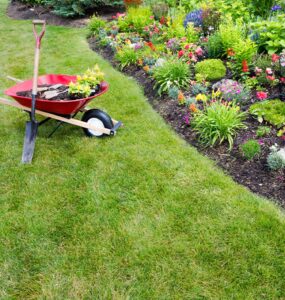
Pruning in April
By Rob Sproule
April is the gardeners’ pacing month. The snow has melted, the sun warms us and the brown, bare garden taunts us. When it’s too warm to be inside but too cold to plant, what’s an early bird to do? Luckily, it’s the perfect month to prune.
In April, you won’t have to trudge through snow to get to the trees, but with no leaves yet, it’s easy to strategize where to prune. Here’s a quick guide on what to cut and why.
Also see Your Pruning Calendar for best pruning times year round.
Rules of Thumb
Before you start hacking away, the most important thing to remember is the rule of thirds.
Unless you’re pruning out a nasty pest like Black Knot, never cut off more than a third. Doing so will shock the plant’s system and can do lasting damage as it loses so much of its ability to photosynthesize. Think of trees’ leaves as their stomachs; if you lost half your stomach capacity it would weaken you substantially.
Ideally, develop an end vision for your shade or fruit trees when you plant them. That way you will never have to do intensive pruning to train them. If you move into a house with wild, immature trees that need considerable remedial work, develop a multi-year plan to prune back a third each year until it is where you want it to be.
Tools of the Trade
Make sure your tools are cleaned and the appropriate ones for the job. You get what you pay for, and I usually advise people that a good pair of pruners is a gardener’s best friend. If you go for the cheapest ones, buy a couple pairs because the first thick branch may either bend the handle or knock off the blade.
Avoid chainsaws unless necessary. Your backyard isn’t backwoods BC. Besides being overkill, the chain will leave a jagged wound that will take a long time to heal.
After pruning, especially if you’re pruning out disease, disinfect your tools with a light bleach solution. Try to keep them sharp as well. These are surgical instruments; the sharper and cleaner they are, the less harm to the patient.
Why are you Pruning?
The first rule of pruning is: don’t prune unless you have a reason. Don’t prune just to get out into the garden. Trees and shrubs all have natural forms that they will try to grow into, and natural forms are always more beautiful than those we impose.
Prune if you’re growing fruit trees and need to train the limbs. Pruning apples and cherries for maximum yield is a science of selecting a few strong branches and forsaking the others.
If you have large shade trees and want to be able to walk under them, you’ll want to prune the lower branches up to the lowest “permanent” branch. Look for the strongest branch that grows about a third of the way up the trunk. Branches below that are temporary branches and you can remove them.
Prune if you’re concerned about the tree’s health and/or your safety. If winter has left broken or weakened limbs or if limbs are visibly diseased, now is the time to prune them out.
Limbs are actively competing for the same space, either crossing over each other or growing awkwardly close, prune out the weaker to feed more resources to the stronger. Pruning out trees’ dense interior also controls disease by allowing for more air circulation. Increased air circulation keeps foliage drier and discourages airborne fungus and bacteria.
Best Trees for April Pruning
If you were hoping to prune your Elm tree, you’re too late. In Alberta it’s illegal to prune elms between April 1 and Sept 30, so make a note in your calendar for October. The reason is so our elms don’t get obliterated by Dutch Elm disease, so please follow the rule.
A tree’s dormancy is the best time to prune it, so ease off once the buds are ready to open. Hold off pruning birch and maple until mid summer; in early spring their sap is running so quickly that they will bleed out. Other deciduous trees, including fruit trees, are fine to prune in April.
Evergreens don’t usually need much pruning. If you’re pruning for shape, pines are best cut in mid June (just before new needles unfold). Prune spruce and fir before mid-May so you don’t sacrifice next year’s buds.















